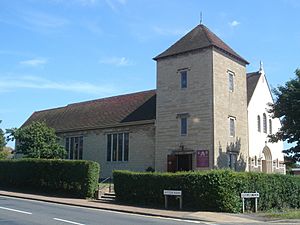Church of St Thomas More, Seaford facts for kids
Quick facts for kids Church of St Thomas More |
|
|---|---|

The church from the northwest
|
|
| 50°46′26″N 0°06′26″E / 50.7739°N 0.1073°E | |
| Location | 54 Sutton Road, Seaford, East Sussex BN25 1SS |
| Country | England |
| Denomination | Roman Catholic |
| History | |
| Status | Church |
| Founded | 1935 |
| Dedication | Thomas More |
| Events | 1969: extended by Henry Bingham Towner |
| Architecture | |
| Functional status | Active |
| Architect(s) |
|
| Completed | 12 March 1936 |
| Administration | |
| Parish | Seaford |
| Deanery | Eastbourne |
| Diocese | Arundel and Brighton |
The Church of St Thomas More is a Catholic church located in Seaford, East Sussex, England. It is a special place of worship for the local community. About 200 people attend services here regularly. The current leader of the church is Deacon Stephen Sharpe.
Contents
Exploring the Church's Design
The Church of St Thomas More is built in the shape of a cross. This is a traditional design for many churches. Inside, it has four main walkways, called aisles. The main altar, where services are held, faces the people.
Inside the Church Building
The north aisle is the longest part of the church. It stretches around the side of the altar. Two central aisles lead directly to the main altar. The south aisle faces the Lady Altar. This area also has a special room for confessions and a library.
Special Features and Entrances
The church has an organ-loft, which is a raised area for the organ. This space is used when many people attend services. Outside, at the front, there is a small cemetery for ashes. There is also a car park for visitors. The church has two entrances. One is used every day, and the other is for special events. The priest's house and the parish hall are connected to the church building.
A Look at the Church's History
At the start of the 1900s, there were only six Roman Catholics in Seaford. Soon after, Bishop Francis Bourne of Southwark built a small chapel. It was named after St Francis de Sales. This chapel was next to his holiday home, called Annecy.
From Chapel to Convent
In 1903, a group of nuns, the Sisters of Providence, bought the chapel. They turned it into a convent and a school. Father Berchmans regularly led church services there. Sadly, he passed away suddenly in 1927.
Growing Community Needs
After Father Berchmans, Father Reginald Webb became the first parish priest. By then, the Catholic community had grown to 100 people. The chapel was too small for everyone. So, they moved services to the hall at Annecy School. The number of people continued to grow.
Building a New Church
In 1935, the community decided to build a new church. It officially opened its doors on March 12, 1936. The total cost to build the church was about £10,000. By this time, about 250 people were attending services.
Changes and New Leaders
Father Webb passed away in 1962. Father William Guinane took over as parish priest. In 1970, he made the church bigger. He extended the south aisle and added a north aisle and a tower. In 1965, the church became part of the new Diocese of Arundel and Brighton.
Further Developments and Priests
In 1980, Father Kenneth McCarthy became the third parish priest. He added a hall and a car park for the church. In 1990, Father Chris Benyon replaced him due to health reasons. Father Chris Benyon supported music groups at the church. He left the parish in 1999, and Father Tony Churchill stepped in.
Recent Years and Celebrations
In 2004, Annecy School celebrated its 100th birthday. Bishop Kerian Conry led a special service with over 500 people. Father Niven Richardson became the parish priest in 2007, replacing Father Tony Churchill. The church is officially registered for worship under the Places of Worship Registration Act 1855. Its registration number is 56568.
Church Leaders Over Time
- Fr Reginald Webb (1927–1962)
- Fr William Guinane (1963–1980)
- Fr Kenneth McCarthy (1980–1990)
- Fr Chris Benyon (1990–1999)
- Fr Anthony Churchill (1999–2007)
- Fr Niven Richardson (2007–2011)
- Fr Paul Jennings (2011–2019)
- Fr Ian Byrnes (2019-2022)
- Deacon Stephen Sharpe (2022-)

